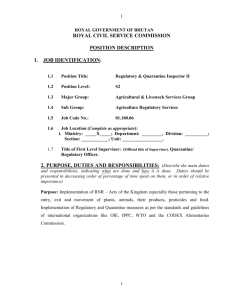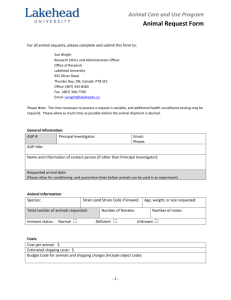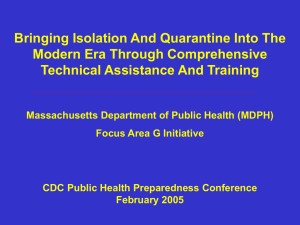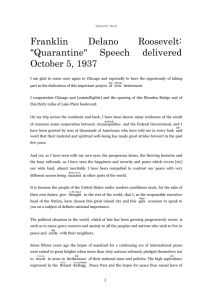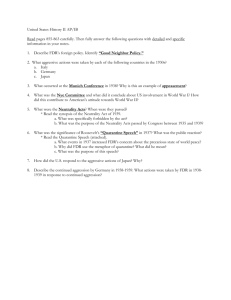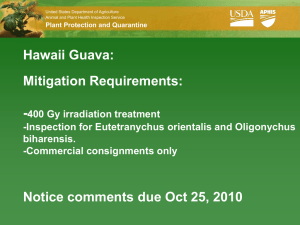An Electronic System for Monitoring Persons in Isolation or Quarantine
advertisement
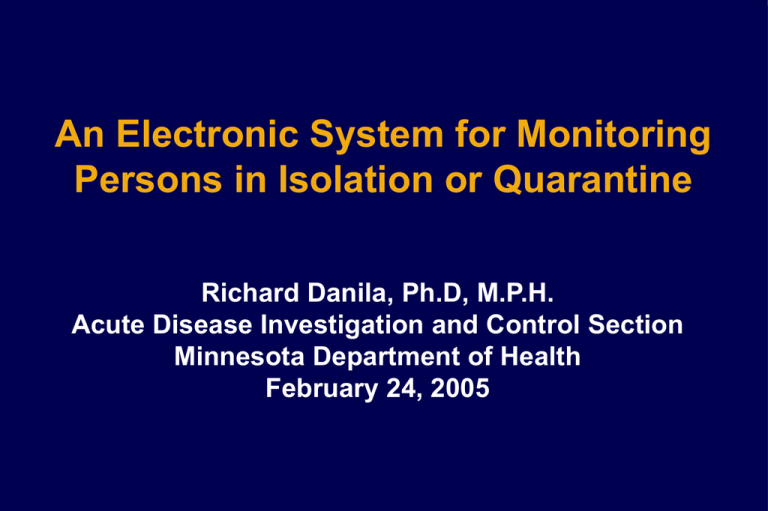
An Electronic System for Monitoring Persons in Isolation or Quarantine Richard Danila, Ph.D, M.P.H. Acute Disease Investigation and Control Section Minnesota Department of Health February 24, 2005 Definitions of Isolation and Quarantine (I/Q) • Isolation – Separation and restriction of movement and activities of ill persons with a contagious disease for the purpose of preventing disease transmission • Quarantine – Separation and restriction of movement and activities of persons who are not ill but are believed to have been exposed to infection for the purpose of preventing disease transmission I/Q Re-emergence as a Disease Control Strategy • Bioterrorism concerns revitalized interest in I/Q – CDC sponsored draft of Model State Emergency Health Powers Act – In 2002 Minnesota Legislature updated old I/Q laws • In response to Severe Acute Respiratory Syndrome (SARS) outbreak in 2003 several countries (Canada, Hong Kong, Singapore, and China) extensively used modern I/Q Number of Probable SARS Cases in Canada by Symptom Onset Date and Number of Persons in Quarantine February 23 to June 30, 2003 (N=249), excludes 1 case for whom onset date is unknown Quarantine for SARS, Ontario, 2003 • 23,297 contacts followed up • Up to 7,000 persons in quarantine at any time • Monitoring conducted through phone calls; 1 or 2 calls per day • Monitoring documented using a paper system Ellis Island Quarantine Station 21st Century Isolation/Quarantine Station I/Q Monitoring System: Need • In September 2003, the Minnesota Department of Health (MDH) determined that a computerized monitoring system would be critical for managing large-scale I/Q for SARS • Disease reporting is centralized in Minnesota but follow-up may occur at either the state or local level; the system must coordinate monitoring and assurance of essential services activities between state and local public health Purpose of Monitoring Persons in I/Q • Monitor the health status of persons in I/Q • Ensure that persons in I/Q are compliant with restrictions • Ensure that persons in I/Q have basic needs met (e.g., food, clothing, housing, medical needs, etc.) • Ensure that persons in I/Q have appropriate infection control supplies I/Q Monitoring System: Goals • Develop a system for monitoring persons in I/Q • Flexibility – built on assumptions (e.g., number of days in I/Q may vary) – allow parameters to be updated as more information is gained • Accommodate different diseases where I/Q may be implemented • Creates automated reports I/Q Monitoring System: Goals (cont.) • Accommodate different levels of monitoring: – isolation – quarantine – monitoring without I/Q (e.g., person is monitored for symptom development but not placed in quarantine) • Documentation for each person – communication with the individual – compliance with I/Q – essential service needs - health status - legal orders Outline of Monitoring • Persons would be contacted twice daily; 3 phone attempts would be made • If all 3 phone attempts fail, local public health will conduct a home check • The following information needs would be collected during monitoring calls: – Temperature – New or worsening symptoms consistent with SARS – Symptomatic household contacts – Essential services needed Monitoring Follow-up • If 3 phone attempts and home check fail the Medical/Legal Management Team will determine next steps • If a person being monitored reports new or worsening symptoms, the Clinical Team will review to determine appropriate follow-up • If services are needed and the monitored person is unable to obtain them, the request will be referred to local public health Primary Assumptions • Limited number of staff would be responsible for data entry and data management • Other staff would view information on a specific person, but would not need to learn entire system • System must provide information to and accept data from local public health agencies, since they would fulfill essential services and conduct some monitoring calls • Monitoring calls could be documented on paper and then data entered into the application Development Process • Team of 11 IT staff and 3 epidemiologists • Timeline: Initiated October 2003 with a goal of an operational system by December 2003 Development Process (cont.) • System was developed, tested and implemented in a staged approach – Release 1: information essential to conducting monitoring if an outbreak occurred – Release 2: enhancements and web-based data entry (for local public health) – Release 3: legal order information and additional enhancements – Further enhancements considered (e.g., complete webbased system; disease specific enhancements for smallpox, novel influenza) Architecture • Developed a case-centered (i.e., person being monitored) system • MS Access front-end was used for user interface • Perl was used to generate reports • Perl was used to create a delimited export file for epidemiologic analysis • Java was used for web-based data entry • Database was deployed in Oracle Monitoring Data • • • • • • • • • • Person information Contact information Work, school, and daycare information Orientation to I/Q call (Day zero) Monitoring calls Incoming calls from the person in I/Q or on their behalf Symptoms Service needs Court order information Restricted entry information Reports • The system generates 9 daily reports • Internal reports “flag” persons who require followup or further evaluation (e.g., non-compliance, new or worsening symptoms) • Local public health receives reports of: – all persons in I/Q in their jurisdiction – daily calls needed to be made (if local public health is responsible for monitoring) • Communication with local public health – Initial release - reports communicated via fax/phone – Future release - reports communicated via encrypted file Isolation/Quarantine Monitoring System: Screens Subject Isolation/Quarantine Location Isolation/Quarantine Status Contacts Monitoring Calls Day Zero Call Incoming Calls Court Order Print Me Web Form Web Form Monitoring Attempt Web Form Service Follow-up Challenges • Tight timelines • No practical experience with large-scale isolation or quarantine • System built on assumptions; additional need for flexibility • Varying technical capabilities of local public health agencies Challenges (cont.) • Funding and staff needs – Impact on regular tasks • Staff pulled from multiple IT areas • Lack of staff continuity may make updates difficult • Funding necessary for future changes/enhancements Acknowledgements • • • • • • • • Ali Kress Deb Boyle Duy Pham Franci Livingston Hung Nguyen Jessica Buck Jim Miller Joe Fierst • • • • • • Kathy Como-Sabetti Keith Hammel Lynn Shellenbarger Mansour Hadidi Mark Hallock Steve Holm
